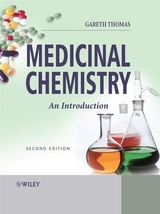
Medicinal Chemistry
John Wiley & Sons Ltd (Verlag)
978-0-471-98807-6 (ISBN)
- Titel erscheint in neuer Auflage
- Artikel merken
Medicinal Chemistry: An Introduction, provides a comprehensive, balanced introduction to this exciting, evolving and multi-disciplinary field. This text assumes little prior knowledge of medicinal chemistry and keeps the approach as simple as possible. Focusing on the chemical principles used for drug discovery and design, it also covers human biology where relevant. Each chapter has a summary of its contents, self-assessment questions, numerous examples and applications.
Chapter 1:Introduction What are drugs and why do we need new ones? Drug discovery and design, a historical outline Methods and routes of administration, the pharmaceutical phase Introduction to drug action Classification of drugs Drug Stability Sources of Drugs Drug development and production Summary Chapter 2: Drug Discovery By Design Introduction Stereochemistry and drug design Structure-activity relationships (SAR) Quantitative structure-activity relationships (QSAR) Computer-aided drug design Combinatorial chemistry Summary Chapter 3: Drug solubility Introduction The structure of bulk liquids Solutions Solubility Solubility and the structure of the solute Salt formation The incorporation of water-solubilising groups in a structure Formulation methods of improving water solubility The effect of the pH on the solubility of acidic and basic drugs Partition Surfactants, structure and action Summary Chapter 4: Biological membranes Introduction The plasma membrane The transfer of species through cell membranes Drug action that affects the structure of cell membranes and walls Summary Chapter 5: Pharmacokinetics Introduction Drugs Pharmacokinetic models Intravascular administration Extravascular administration The use of pharmacokinetics in drug design Extraploation of animal experiments to humans Summary Chapter 6 - Enzymes Introduction Classification and nomenclature Active sites and catalytic action Regulation of enzyme activity The specific nature of enzyme action The mechanisms of enzyme action The general physical factors affecting enzyme action Enzyme kinetics Enzyme inhibitors Transition state inhibitors Enzymes and drug design: some general considerations Examples of drugs used as enzyme inhibitors Ribozymes Summary Chapter 7: Complexes and chelating agents Introduction The shapes and structures of complexes Stability The general roles of metal complexes in biological processes Therapeutic uses Drug action and metal chelation Summary Chapter 8: Receptors and messengers Introduction The bonding of ligands to receptors Structure and classification of receptors General mode of operation Ligand-response relationships Drug action and design Summary Chapter 9: Drug Metabolism Introduction Secondary pharmacological implications of metabolism Sites of action Phase I metabolic reactions Phase II metabolic routes Pharmacokinetics of metabolites Drug metabolism and drug design Prodrugs Summary Chapter 10: Nucleic acids Introduction Deoxyribonucleic acids (DNA) The general functions of DNA Genes Replication Ribonucleic acids (RNA) Messenger RNA (mRNA) Transfer RNA (tRNA) Ribosomal RNA (rRNA) Protein synthesis Protein synthesis in prokaryotic and eukaryotic cells Bacterial protein synthesis inhibitors (antimicrobials) Drugs that target nucleic acids Viruses Recombinant DNA (genetic engineering) Summary Chaper 11: Nitric oxide Introduction The structure of nitric oxide The chemical properties of nitric oxide The cellular production and role of nitric oxide The role of nitric oxide in physiological and pathophysiological states Therapeutic possibilities Summary Chapter 12: An introduction to organic drug and analogue synthesis Some general considerations Asymmetry in syntheses Designing organic sysntheses Partial organic synthesisn of xenobiotics Summary
| Erscheint lt. Verlag | 27.10.2000 |
|---|---|
| Zusatzinfo | Illustrations |
| Verlagsort | Chichester |
| Sprache | englisch |
| Maße | 195 x 241 mm |
| Gewicht | 1140 g |
| Einbandart | gebunden |
| Themenwelt | Medizin / Pharmazie ► Medizinische Fachgebiete ► Pharmakologie / Pharmakotherapie |
| Naturwissenschaften ► Chemie | |
| Technik | |
| ISBN-10 | 0-471-98807-3 / 0471988073 |
| ISBN-13 | 978-0-471-98807-6 / 9780471988076 |
| Zustand | Neuware |
| Haben Sie eine Frage zum Produkt? |
aus dem Bereich



